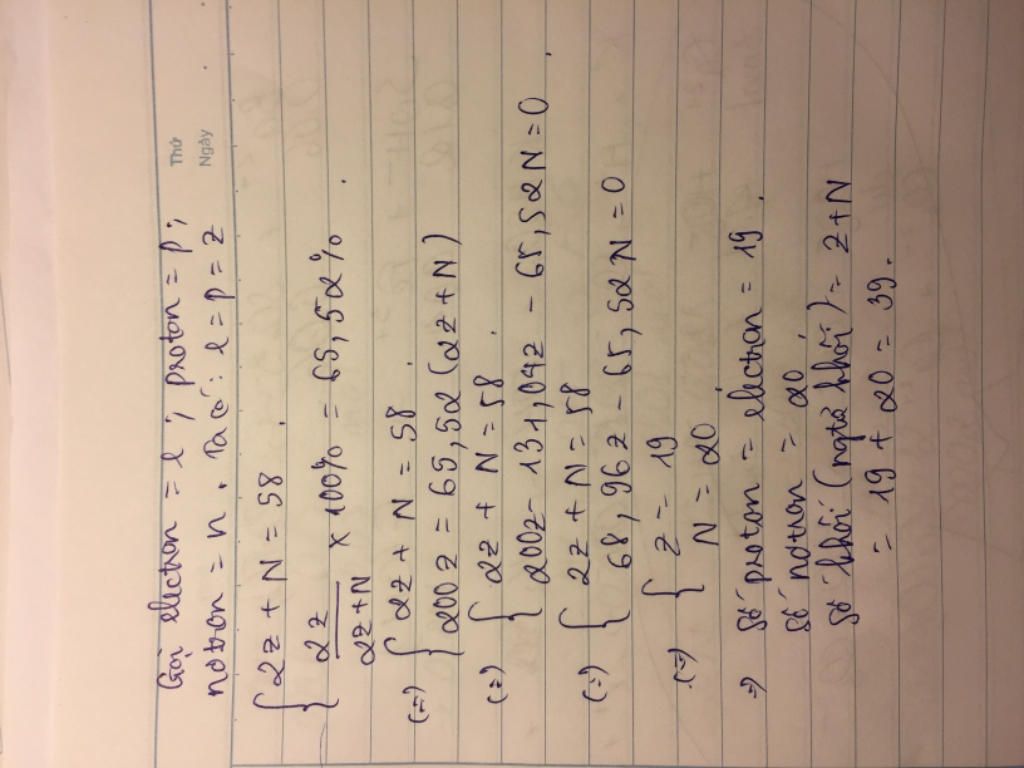Hãy nhập câu hỏi của bạn vào đây, nếu là tài khoản VIP, bạn sẽ được ưu tiên trả lời.

theo đề bài ta có:
\(p+e+n=28\)
\(n=10\)
\(\Rightarrow p+e=18\)
mà \(p=e\)
\(\Rightarrow p=e=\dfrac{18}{2}=9\)
vậy \(p=19\)

\(X(2p; n)\\ X: 2p+n=31(1)\\ MĐ > KMĐ: 2p-n=10(2)\\ (1)(2)\\ a/\\ p=e=11\\ n=12\\ b/\\ Tên: Natri\\ KH: Na\\ NTK:23\)

a) Theo đề bài ta có: \(p+n+e=34\) \(\Rightarrow2p+n=34\left(1\right)\)
Ta có: Số hạt mang điện nhiều hơn số hạt không mang điện là 10\(\Rightarrow p+e-n=10\Rightarrow2p-n=10\left(2\right)\)
Từ \(\left(1\right),\left(2\right)\Rightarrow\left\{{}\begin{matrix}p=11\\n=12\end{matrix}\right.\)
\(\Rightarrow e=p=11\)
b) Nguyên tử khối của X: \(p+n=11+12=23\left(đvC\right)\)
Vậy X là Natri, kí hiệu là Na

câu 9:
theo đề bài ta có:
\(p+n+e=94\)
mà \(p=e\)
\(\Rightarrow\left\{{}\begin{matrix}2p+n=94\\2p-n=22\end{matrix}\right.\)
\(\Leftrightarrow\left\{{}\begin{matrix}2n=72\\2p-n=22\end{matrix}\right.\Leftrightarrow\left\{{}\begin{matrix}n=36\\2p-36=22\end{matrix}\right.\Leftrightarrow\left\{{}\begin{matrix}n=36\\p=29\end{matrix}\right.\)
vậy \(p=e=29;n=36\)
số khối \(\left(A\right)=29+36=65\)
\(\Rightarrow A\) là kẽm\(\left(Zn\right)\)

ta có
P+E+N=94 =>2P+N=94
P+E-N=22 => 2P-N=22
=> P=E=29,N = 36
=> A là kim loại đồng (Cu)

Số hạt notron = 28.35,7% = 10(hạt)
Số hạt proton = ( 28 - 10 ) : 2 = 9(hạt)
Đáp án A
\(TC:\)
\(2p+n=28\)
\(\dfrac{n}{28}\cdot100\%=35.7\%\Rightarrow n=10\)
\(\Rightarrow p=9\)